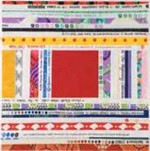 Log Cabin Library Block by Karen Griska
Log Cabin Library Block by Karen Griska
The Log Cabin quilt pattern is one of the most beloved and recognized of quilt designs. However, it may be both older and newer than you might think. While it’s natural to assume that this traditional block originated in the United States during the pioneer days, the origins of the block seem to go back much further in time and location. Similar designs have been found on ancient Egyptian mummies and in an English quilt predating 1830.
Log Cabin quilts first made a wide-spread appearance in the United States in the 1860s during the time of the Civil War. The block name may very well have had a connection to the presidency of Abraham Lincoln. The Log Cabin quilt became wildly popular and was identified with the pioneer spirit and values of America.
Early Log Cabin blocks were hand-pieced using strips of fabrics around a central square. In traditional Log Cabin blocks, one half is made of dark fabrics and the other half light. A red center symbolized the hearth of home and a yellow center represented a welcoming light in the window. Anecdotal evidence, based on oral folklore, suggests that during the Civil War, a Log Cabin quilt with a black center hanging on a clothesline was meant to signal a stop for the Underground Railroad.
In the latter part of the nineteenth century, many Log Cabin quilts were made by the foundation method with a muslin base. Wools, velvets, satins, and other nontraditional fabrics were used. Log Cabins of this period often had strips that were folded and laid down creating a three-dimensional effect. For this reason, many late-nineteenth-century Log Cabins do not have batting but are backed and tied like Crazy Quilts.
Variations of settings appeared with names reflecting the themes of the times. The White House Steps, Court House Steps, eight-sided Pineapple, Barn Raising, and Sunshine and Shadows are just some of the hundreds of name and pattern variations.
As Victorian quilts of wool and silk fell out of style in the twentieth century, Log cabins were more often made of cotton prints and pieced with a running-stitch seam either by hand or machine.
Today, Log Cabin quilts are natural candidates for strip-piecing and can be made in a fraction of the time it took our ancestors. Log Cabins are still a favorite choice for scrap quilts and there is even a resurgence of Crazy Quilts made using Log Cabin blocks.
It’s virtually impossible to run out of ways to make beautiful Log Cabin quilts. The Log Cabin is certainly a pattern not likely to go out of “style” any time soon.
You can download the Free Log Cabin Library pattern made using fabric selvages. It’s your gift from AQS.
Click here to download your FREE pattern.
AQS
Save